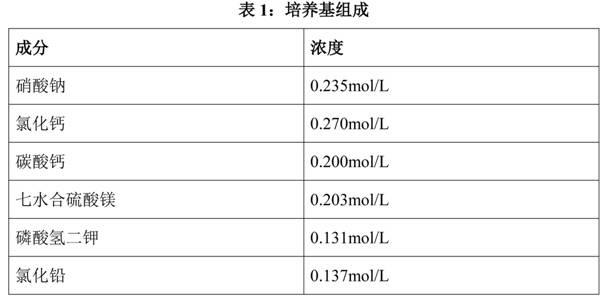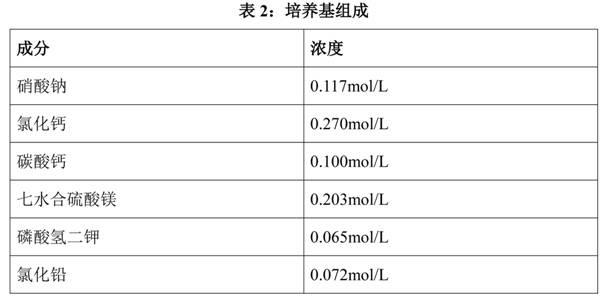Culture medium of single-cell microalgae and method for treating lead-containing wastewater by using single-cell microalgae
A single-cell algae and culture medium technology, which is applied in the direction of single-cell algae, chemical instruments and methods, biological water/sewage treatment, etc., can solve the problems of poor treatment effect, achieve the effect of green environmental protection and reduce lead pollution
- Summary
- Abstract
- Description
- Claims
- Application Information
AI Technical Summary
Problems solved by technology
Method used
Image
Examples
Embodiment 1
[0036] Cultivate S. qingdao in the medium shown in Table 1 (closed culture), the inoculation density is 5 million cells / ml, and the culture temperature is 25°C. After 5 days of culture, centrifuge and concentrate 10 times to obtain unicellular algae Concentrate, transfer the concentrate to the prepared 0.2% agar semi-solid suspension, and mix well. Inject lead-containing wastewater (Pb in wastewater 2+ The concentration is 80mg / L), after 10 days, inoculate rotifers with a density of 3 / ml, and after another 10 days, filter the water body with a 200-mesh sieve to collect zooplankton, and the water can be discharged directly.
[0037]
[0038] After testing, after treatment, the lead content in wastewater was reduced by 72.3%.
[0039]
Embodiment 2
[0041] Cultivate Sclerophyllum qingdao in the medium shown in Table 2 (closed culture), the inoculation density is 5 million cells / ml, and the culture temperature is 25°C. After 5 days of culture, centrifuge and concentrate 10 times to obtain unicellular algae Concentrate, transfer the concentrate to the prepared 0.7% agar semi-solid suspension, and mix well. Inject lead-containing wastewater (Pb in wastewater 2+ The concentration is 80mg / L), after 10 days, inoculate rotifers with a density of 3 / ml, and after another 10 days, filter the water body with a 200-mesh sieve to collect zooplankton, and the water can be discharged directly.
[0042]
[0043] After testing, the lead content in the wastewater was reduced by 57.4% after treatment.
PUM
 Login to View More
Login to View More Abstract
Description
Claims
Application Information
 Login to View More
Login to View More - R&D
- Intellectual Property
- Life Sciences
- Materials
- Tech Scout
- Unparalleled Data Quality
- Higher Quality Content
- 60% Fewer Hallucinations
Browse by: Latest US Patents, China's latest patents, Technical Efficacy Thesaurus, Application Domain, Technology Topic, Popular Technical Reports.
© 2025 PatSnap. All rights reserved.Legal|Privacy policy|Modern Slavery Act Transparency Statement|Sitemap|About US| Contact US: help@patsnap.com


